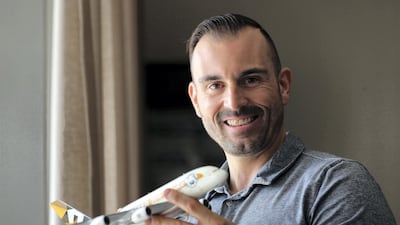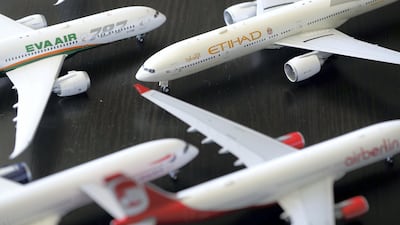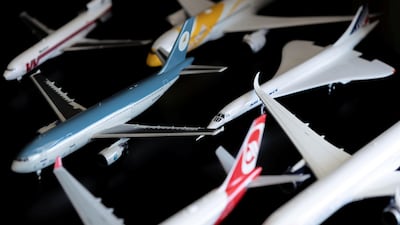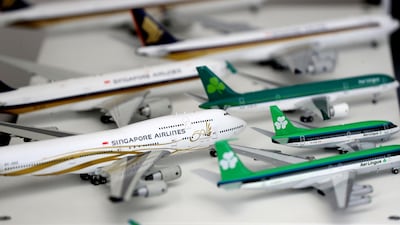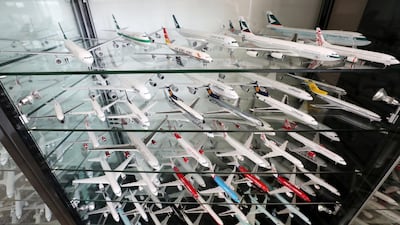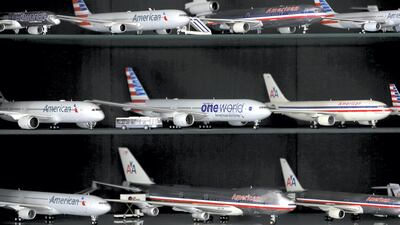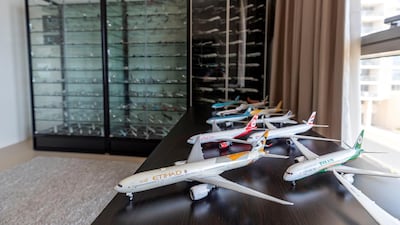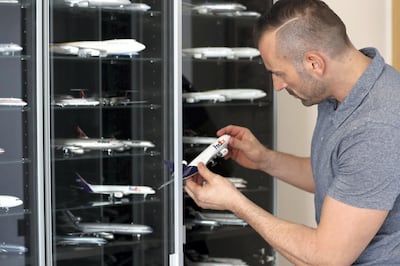Like most pilots, Ben Matar is not currently flying as much as usual.
But as the owner of around 900 planes, he still sees plenty of aircraft.
The Etihad Airways captain owns what he believes to be the largest collection of metal model planes in the UAE, which he estimates to be worth more than Dh330,000 ($90,000).
And just like the full-size versions now parked up at terminals around the world due to coronavirus, the biggest issue he faces is insufficient storage space.
“Sometimes I like to display them in different ways," said the Australian, who flies Boeing 777 and 787 commercial jets.
"I take them all out and display them in aircraft types, like 777 or 380s, all together.
“But now I have gone back and displayed them in airlines, so I have put all the Etihad ones together and so on. Often I just walk past and have a look at them.”
Mr Matar, who lives in a three-bedroom apartment in Abu Dhabi, first became interested in model planes when he was a child, when he built them from kits.
But as he got older he discovered the collectible die-cast versions, which he displays in cabinets around his home.
The issue he has with storage is compounded by the fact that he also keeps the boxes the aircraft come in.
“I have some models that are probably worth about $400, $500 or $600 each," he said. "But in order to get those prices you have to keep all the boxes.
“So I have a whole storage room downstairs full of big packing boxes, with the boxes with the models inside, not only for if I was to sell any but if I move house I have to pack them.”
Mr Matar, 41, said he kept a thorough record of every model he owns on a spreadsheet, including aircraft registration and airline.
He said most collectors tended to focus on buying specific airlines or aircraft types, although he did not.
Instead, his collection is inspired by the planes he sees while flying around the world.
He owns at least one model plane from all of the world’s major airlines, and all of the aircraft he has ever flown.
“I used to just buy pretty much everything," he said. "But now I have so many I am a bit more choosy in what I collect.
“What I want to do one day is actually set up a scale airport, a terminal or something. You can buy all the little refuelling trucks and the stairs, so I have a lot of that as well.
“It’s important if you have all the stuff you display them correctly.”
Mr Matar, who has worked for Etihad for seven years, said a really good model featured all the details you would expect to see on a real airplane.
His are all on the same scale, at 1/200 the size of the real thing. “I don’t like to mix and match because then it’s not realistic," he said of his collection.
COMPANY PROFILE
Company name: BorrowMe (BorrowMe.com)
Date started: August 2021
Founder: Nour Sabri
Based: Dubai, UAE
Sector: E-commerce / Marketplace
Size: Two employees
Funding stage: Seed investment
Initial investment: $200,000
Investors: Amr Manaa (director, PwC Middle East)
UAE currency: the story behind the money in your pockets
Who is Tim-Berners Lee?
Sir Tim Berners-Lee was born in London in a household of mathematicians and computer scientists. Both his mother, Mary Lee, and father, Conway, were early computer scientists who worked on the Ferranti 1 - the world's first commercially-available, general purpose digital computer. Sir Tim studied Physics at the University of Oxford and held a series of roles developing code and building software before moving to Switzerland to work for Cern, the European Particle Physics laboratory. He developed the worldwide web code as a side project in 1989 as a global information-sharing system. After releasing the first web code in 1991, Cern made it open and free for all to use. Sir Tim now campaigns for initiatives to make sure the web remains open and accessible to all.
New UK refugee system
- A new “core protection” for refugees moving from permanent to a more basic, temporary protection
- Shortened leave to remain - refugees will receive 30 months instead of five years
- A longer path to settlement with no indefinite settled status until a refugee has spent 20 years in Britain
- To encourage refugees to integrate the government will encourage them to out of the core protection route wherever possible.
- Under core protection there will be no automatic right to family reunion
- Refugees will have a reduced right to public funds
Killing of Qassem Suleimani
Dust and sand storms compared
Sand storm
- Particle size: Larger, heavier sand grains
- Visibility: Often dramatic with thick "walls" of sand
- Duration: Short-lived, typically localised
- Travel distance: Limited
- Source: Open desert areas with strong winds
Dust storm
- Particle size: Much finer, lightweight particles
- Visibility: Hazy skies but less intense
- Duration: Can linger for days
- Travel distance: Long-range, up to thousands of kilometres
- Source: Can be carried from distant regions
The%20US%20Congress%20explained
%3Cp%3E-%20Congress%20is%20one%20of%20three%20branches%20of%20the%20US%20government%2C%20and%20the%20one%20that%20creates%20the%20nation's%20federal%20laws%3C%2Fp%3E%0A%3Cp%3E-%20Congress%20is%20divided%20into%20two%20chambers%3A%20The%20House%20of%20Representatives%20and%20the%20Senate%3C%2Fp%3E%0A%3Cp%3E-%C2%A0The%20House%20is%20made%20up%20of%20435%20members%20based%20on%20a%20state's%20population.%20House%20members%20are%20up%20for%20election%20every%20two%20years%3C%2Fp%3E%0A%3Cp%3E-%20A%20bill%20must%20be%20approved%20by%20both%20the%20House%20and%20Senate%20before%20it%20goes%20to%20the%20president's%20desk%20for%20signature%3C%2Fp%3E%0A%3Cp%3E-%20A%20political%20party%20needs%20218%20seats%20to%20be%20in%20control%20of%20the%20House%20of%20Representatives%3C%2Fp%3E%0A%3Cp%3E-%20The%20Senate%20is%20comprised%20of%20100%20members%2C%20with%20each%20state%20receiving%20two%20senators.%20Senate%20members%20serve%20six-year%20terms%3C%2Fp%3E%0A%3Cp%3E-%20A%20political%20party%20needs%2051%20seats%20to%20control%20the%20Senate.%20In%20the%20case%20of%20a%2050-50%20tie%2C%20the%20party%20of%20the%20president%20controls%20the%20Senate%3C%2Fp%3E%0A
Read more about the coronavirus
UAE currency: the story behind the money in your pockets
